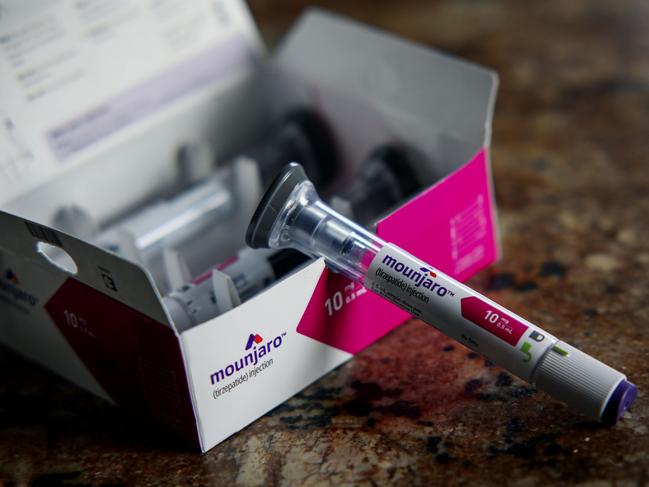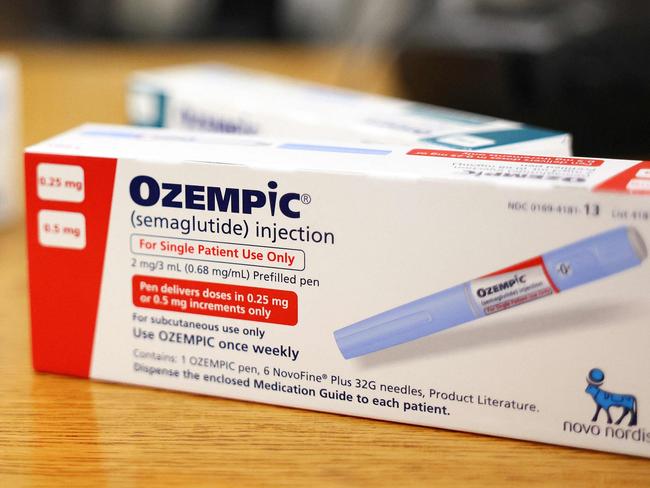Ozempic, Mounjaro, Wegovy: What you need to know about these medications
As more and more Aussies are seeking out medications to help lose weight, here’s what you need to know about them and their risks.

Health
Don't miss out on the headlines from Health. Followed categories will be added to My News.
Three medications are available in Australia that can be prescribed to help people lose weight.
Here’s everything you need to know about them.
What options are available in Australia?
Semaglutide injections is a type of medication used to treat type 2 diabetes but it has also been shown to help with weight loss.
Ozempic and Wegovy are branded versions of semaglutide made by pharmaceutical company Novo Nordisk.
Ozempic has been available in Australia for some time but Wegovy was only made available in August.
Ttirzepatide is also an injectable used to treat type 2 diabetes. It is made by Eli Lily sold under the brand Mounjaro.
As with Ozempic, it has also has been prescribed off-label to manage weight loss.

What do they do? How do they differ?
Semaglutide works as a glucagon-like peptide-1 (GLP-1) receptor agonists, which work like a hormone to help the body lower it’s blood sugar levels.
Tirzepatide is both a GLP-1 receptor agonist and a glucose-dependent insulinotropic polypeptide (GIP) receptor agonist.
These medications help people with Type 2 Diabetes with their blood sugar levels, and help people lose weight.
Wegovy has been specifically approved by the Therapeutic Goods of Australia for chronic weight management in adults and adolescents.
Wegovy and Ozempic contain the same active ingredient but they have different dosages and delivery devices, the TGA said in a statement issued in August.
Mounjaro has also just been approved by the TGA to be used in chronic weight management for adults, according to Eli Lily.

What is the latest with shortages on Ozempic?
Novo Nordisk is expecting supplies of its product Ozempic to be in limited supply for the remainder of this year.
The pharmaceutical company said demand for Ozempic, particularly the low-dose version, had accelerated in recent months, stating the additional demand was caused an increase in “off-label” prescriptions.
Making Ozempic involves a complex process using specialised equipment, so it’s not easy to just quickly make more.
Do the others have shortages as well?
Wegovy has only just been made available here in Australia and as yet, it’s unclear how stock levels are going.
There have been shortages of Mounjaro in Australia but that was expected to ease by the end of August, according to the TGA’s website.
Who can get the medication?
The TGA has approved Mounjaro to be used for chronic weight management in adults with a BMI of 30 or above and adults with a BMI of 27 or above who have at least one weight-related comorbidity, according to Eli Lily.
Wegovy has been approved under the same conditions, according to the TGA’s website.
Roughly one in three Australians have a BMI greater than or equal to 30, reports The Medical Republic.
What are the known side effects of these drugs?
Wegovy common side effects:
- Nausea
- Diarrhea
- Vomiting
- Constipation
- Belly paint
- Indigestion
- Dizziness
- Bloated stomach
- Burping/gas
- Low blood sugar
- Gastroenteritis
- GERD
- Headache
- Fatigue
- Nose and throat infections

Ozempic common side effects:
- Nausea
- Vomiting
- Diarrhea
- Belly pain
- Constipation
Mounjaro common side effects:
- Nausea
- Diarrhea
- Reduced appetite
- Vomiting
- Constipation
- Indigestion
- Belly pain
What have studies shown so far?
A 2021 UK study of 1961 adults, who were classified as overweight or obese and did not have diabetes, were randomly assigned weekly semaglutide or a placebo for 68 weeks. The study, published in the New England Journal of Medicine, found that those on the medication lost an average of 14.9 per cent of their body weight compared to 2.4 per cent for those on the placebo. In kilograms, that was 15.3kg compared to 2.6kg for those not on the medication.
Another study in the US, published in the JAMA Network Open, found 175 people who were given weekly injections of semaglutide has lost an average of 12.3kg over the first six months, or 10.9 per cent of their total body weight.
Meanwhile, another study published in the Jama Network Open examined the link between semaglutide use and suicidality, using a World Health Organisation database of adverse drug events from 140 countries.
Researchers found there was an elevated risk of suicidal thoughts among an already vulnerable group using semaglutide, compared to those who used other weight loss drugs.
The study authors identified 107 reports of patients experiencing suicidal thoughts while using semaglutide out of over 30,500 total cases.
In comparison, 162 similar reports were found among more than 52,000 patients using liraglutide, a related older diabetes medication.

Common theories about the medications
You’ll gain weight if you stop taking the medication
Yes, people who stop taking tirzepatide or semaglutide can regain weight, according to Dr Natasha Yates, of Bond University.
Several days after stopping the medication people can start to feel hungry again because their brain and gut are no longer receiving the medication that is working to make them feel full, she wrote in a piece for The Conversation.
She said a rise blood sugars can also occur, and in the longer term most people returned to their previous blood pressure and cholesterol levels as the weight came back.
To help reduce weight regain, Dr Yates suggests people coming off semaglutide or tirzepatide make sure they get quality sleep, exercise to help build and maintain muscle, address aspects of one's life that contributes to their over eating or consuming unhealthy foods, and eat healthy.
Compounded semaglutide is the same
Compounded glucagon-like peptide-1 receptor agonists (GLP-1RA) products are not the same as TGA-approved medications like Ozempic, Wegovy or Mounjaro, according to Australia’s Health Department.
“Unlike TGA-approved products, pharmacy-compounded products are not clinically evaluated by the independent regulator for safety, quality or efficacy,” a statement issued in May by the Department of Health read.
“The new regulations will remove GLP-1 RAs, many of which claim to be replicas of Ozempic or Mounjaro, from the pharmacy compounding exemption.
“At least 20,000 Australian patients are injecting these compounded replica weight loss products. The majority are using this for weight loss management.
“There are increasing reports of patients coming to harm from GLP-1 RAs including the hospitalisation of a patient in Australia due to a serious adverse event.”
The side effects are really bad
While diarrhea and nausea are common side effects, in most cases they were not that disruptive to people’s normal routine, studies showed.
Participants of the UK study did report nausea, diarrhea, vomiting and constipation symptoms but they were “typically transient and mild-to-moderate in severity and subsided with time”.
Of the more than 1900 people in that study, only 4.5 per cent (59 people) discontinued treatment because of gastrointestinal side effects. But GI side effects were also reported in about half of the placebo group participants.
The US study had similar findings, with about half experiencing adverse effects, with nausea the most common at 36.6 per cent, followed by diarrhea is 8.6 per cent.
What's the advice from the TGA about them?
The TGA has stated is is not able to stop doctors from using their clinical judgment to prescribe medications, such as Ozempic, for off-label uses.
When the shortages of the medications were announced late last year and again earlier this year, the TGA said it was working with patients, doctors and the pharmaceutical companies to improve access.
One of it’s main requests was for doctors to be mindful of the shortages and only prescribe Ozempic or Mounjaro for its primary intended use, where possible.
It also moved to approve Wegovy for weight loss, to reduce the demand on Ozempic and Mounjaro.
More Coverage
Originally published as Ozempic, Mounjaro, Wegovy: What you need to know about these medications




